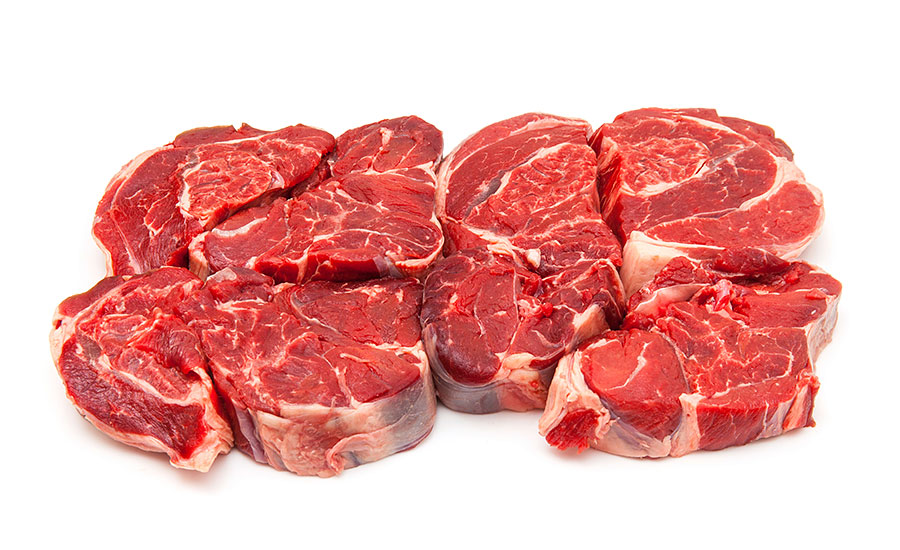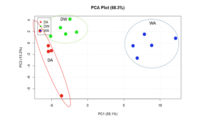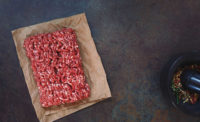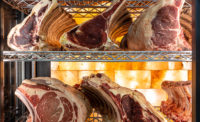Meat Science Review
Physical, thermal properties of beef steaks within different quality grades

The three main palatability characteristics of beef are flavor, tenderness and juiciness (Savell 1987, Lyford 2010, McBee 1967), with tenderness and juiciness being primarily physical properties. Noticeable differences in tenderness and juiciness occur after cooking, and there are numerous studies to support the effects cooked degree of doneness (DOD) and marbling have on all three palatability characteristics (Lorenzen et al., 1999; Campion, Crouse, & Dikeman 1975). During cooking, heat changes beef through moisture loss, fat migration and protein degradation (Jones et al., 1992). Moisture and fat transfer heat differently (Cross 2006), but the impact of beef composition or quality grade on beef thermal properties are currently unclear. This project was conducted to establish a baseline of the physical and thermal properties of raw beef steaks within different quality grades.
Tests to evaluate the physical and thermal properties of different raw beef strip steaks from USDA Prime, Low Choice and Standard grades were conducted at 39°F. Texture was evaluated through measurements for tenderness, chewiness, hardness, resilience and springiness were collected. Meanwhile, steak thermal dynamics (heat transfer behavior) and protein degradation were measured. The primary proteins measured in this study were the contractile proteins of myosin and actin, as well as the proteins found within the sarcoplasm. Of all the measurements collected, four were determined to have statistical differences: hardness, resilience, springiness and the degradation of myosin and sarcoplasmic proteins.
Among the textural results, hardness is the peak force of the first compression or bite, resilience is the ability for the sample to return to its original shape and structure, and springiness is how well a product’s resilience holds up over time. Prime steaks had a greater (P < .05) hardness and resilience when compared with Standard steaks. Conversely, Standard steaks had a greater (P < .05) springiness compared with Prime steaks. These tests were conducted on raw steak, so no lipids or proteins had been altered with cooking. Few quality grade differences in textural properties of raw steaks implies that the majority of quality grade’s influence on texture occurs after cooking. However, protein degradation results revealed that quality grade differences occurred prior to cooking.
Protein degradation is an exothermic reaction, meaning it is a chemical reaction that releases energy. The enthalpy of such a reaction is a measurement of the change in energy during the reaction. This change in energy is used as an indication of the heat required to break down proteins. Results indicated that myosin and sarcoplasmic proteins collected from the center of Standard steaks had lower (P < .05) enthalpy during degradation than myosin and sarcoplasmic proteins found in the center of Prime or Low Choice steaks. Meaning that there was less change in energy when the myosin and sarcoplasmic proteins from the center of Standard steaks were degraded in comparison to the degradation of Prime or Low Choice steaks. This difference could impact a number of factors such as cooking rate or gelation of proteins. The cause of this variance is unclear, but the difference is significant.
While protein degradation may not be directly affected by variances in marbling, there could be differences to the proteins within steaks of the different quality grades. Previous research has shown the myosin type and quantity has a moderate effect on tenderness (Klont et.al, 1998, Sazili et.al, 2005). This data suggests that varied amounts of marbling may affect raw steak hardness, resilience and springiness, and may also be related to changes in protein structural properties.
This just skims the surface of understanding what contributes to beef palatability. Further study will include progressive cooking of steaks to different internal temperatures to better understand the impacts of marbling and DOD on the physical and thermal properties of beef. Once these parameters are understood improved processing and cooking procedures may be outlined to maximize palatability. NP
Byline Notes
*Department of Nutrition, Dietetics and Food Sciences, Utah State University Extension
**Department of Mechanical and Aerospace Engineering, Utah State University, Logan, Utah, 84322
References
Campion, D. R., Crouse, J. D., & Dikeman, M. E. (1975). Predictive Value of USDA Beef Quality Grade Factors for Cooked Meat Palatability. Journal of Food Science, 40(6), 1225-228.
Cross, H.R. (1977). Effects of Amount, Distribution, and Texture of Marbling on Cooking Properties of Beef Longissimus. Journal of Food Science, 42(1), 182-185.
Jones, D.K., Savell, J.W., Cross, H.R. (1992). Effects of fat trim on the composition of beef retail cuts – 2. Fat and moisture content of the separable lean. Journal of Muscle Foods, 3(1), 57-71.
Klont, R.E, Brocks, L., Eikelenboom, G. (1998). Muscle fiber type and meat quality. Meat Science, 49(1), 219-229.
Lorenzen, C. L., Neely, T. R., Miller, R. K., Tatum, J. D., Wise, J. W., Taylor, J. F., Buyck, M. J., Reagan, J. O., & Savell, J. W. (1999). Beef customer satisfaction: cooking method and degree of doneness effects on the top loin steak. Journal of Animal Science, 77,637-644.
Lyford C, Thompson J, Polkinghornec R, Millerd M, Nishimurae T, Neathf K, Alleng P, and Belascoa E. “Is Willingness to Pay (WTP) for Beef Quality Grades Affected by Consumer Demographics and Meat Consumption Preferences?” Australasian Agribusiness Review 18.1 (2010): 8-15. Print.
McBee J. L, and Wiles J.A (1967) “Influence of Marbling and Carcass Grade on the Physical and Chemical Characteristics of Beef” Journal of Animal Science, 26, 701-704.
Savell, J.W., Branson R.E, Cross H.R, Stiffler D.M, Wise J.W, Griffin D.B, and Smith G.C, 1987. National Consumer Retail Beef Study: Palatability evaluations of beef loin steaks that differed in marbling. Journal of Food Science: 52:517-519, 532
Sazili, A.Q., Parr, T., Sensky, P.L., Jones, S.W., Bardsley, R.W., Buttery, P.J. (2005). The relationship between slow and fast myosin heavy chain content, calpastatin, and meat tenderness in different ovine skeletal muscles. Meat Science, 69(1), 17-25.
Looking for a reprint of this article?
From high-res PDFs to custom plaques, order your copy today!





